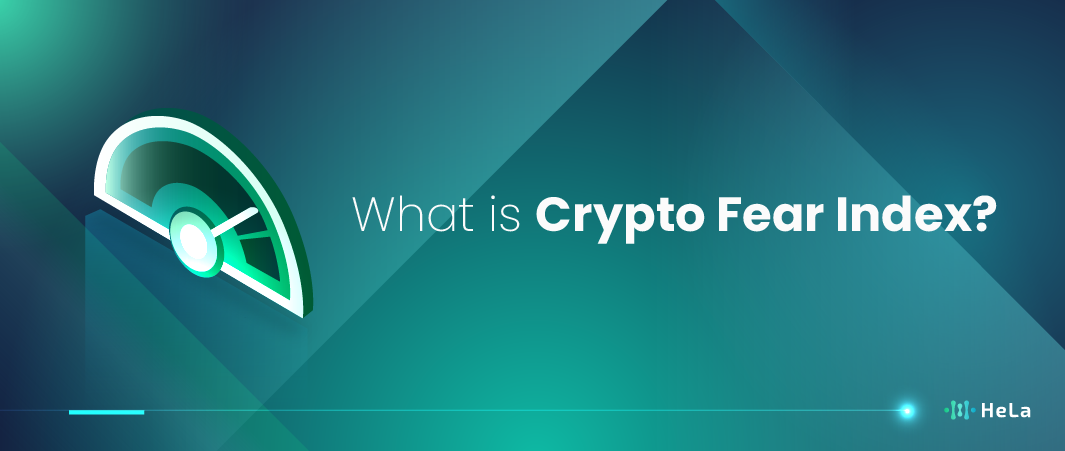The world of cryptocurrency trading is as thrilling as it is volatile, with market sentiments often swinging wildly due to global events, technological developments, and regulatory changes. To navigate this high-stakes environment, traders and investors rely on various tools and indicators. One such tool is the Crypto Fear Index, also known as the Fear and Greed Index. This index is crucial for understanding market mood and making informed decisions.
The Crypto Fear Index measures the emotions and sentiments that sway the market, ranging from extreme fear to extreme greed. Each emotion impacts how investors are likely to react—fear can lead to market sell-offs, while greed can trigger buying sprees. By assessing these emotional states, the index provides a snapshot of market sentiment that can preempt major price movements.
Understanding the Crypto Fear Index is essential for anyone involved in the crypto markets, whether you are a day trader, a long-term investor, or simply a crypto enthusiast. In this article, we will explore what the Crypto Fear Index is, how it works, and its implications for trading decisions. Through a detailed examination, we aim to provide insights that will help you use this index to its fullest potential in your trading strategy.
What is the Crypto Fear Index?

The Crypto Fear Index, often visualized through a numeric scale or a meter, quantifies the sentiment of the cryptocurrency market by analyzing various sources of data. These sources include volatility, market momentum and volume, social media sentiment, surveys, Bitcoin dominance, and trends in Google searches. Each aspect plays a role in the calculation of the index, which ultimately categorizes the market sentiment on a scale from 0 to 100. Scores closer to 0 indicate extreme fear, suggesting a possible undervaluation of markets, while scores near 100 signify extreme greed, which might indicate an overvaluation.
Also Read: 12 Best Decentralized Exchanges in 2024 (Updated List)
Historically, the index has been a reliable indicator of significant market turns. For example, periods of extreme fear often coincide with market bottoms, presenting potential buying opportunities for contrarian investors. Conversely, when the index shows extreme greed, it may be a signal that the market is due for a correction. Therefore, understanding the dynamics of this index can be a critical tool for strategic investment planning.
How is the Crypto Fear Index Calculated?

The Crypto Fear and Greed Index is calculated by combining several factors that provide insight into the emotional state of the cryptocurrency market. Here’s how these factors typically contribute to the index:
Volatility (25%)
This factor evaluates the current volatility of Bitcoin and its maximum drawdowns, comparing these figures to the average values observed over the past 30 and 90 days. Volatility is a critical indicator in financial markets, reflecting the degree of price variation over a given time. In the context of Bitcoin, high volatility is often associated with increased market fear, suggesting uncertainty and potential risk among investors. Monitoring this component helps gauge the emotional climate of the market, where sharp increases in volatility typically signal heightened anxiety and a fear-driven market behavior.
Market Momentum/Volume (25%)
This component assesses the current trading volume and market momentum of Bitcoin by comparing it to historical averages over the last 30 and 90 days. Market momentum, representing the buying and selling pressure, plays a pivotal role in understanding market dynamics. A surge in buying volume during a positive market trend might indicate a decrease in fear, suggesting investor confidence. Conversely, increased selling pressure in a declining market can amplify fear, portraying a lack of confidence and a potential shift towards a bearish market sentiment.
Social Media Sentiment (15%)
This metric involves the analysis of overall sentiment expressed in social media posts concerning cryptocurrencies. By monitoring platforms like Twitter, Reddit, and specialized cryptocurrency forums, this component evaluates the tone and sentiment of public discussions around Bitcoin and other cryptocurrencies. Predominantly negative sentiments in these discussions can significantly increase the fear score, reflecting broader market concerns that may affect investor behavior and market trends.
Surveys (15%)
This approach includes conducting periodic surveys among a sample of traders and investors to gather direct insights into their sentiments regarding the cryptocurrency market. These surveys ask participants to express their feelings and expectations about the market’s future, providing a quantifiable measure of market sentiment. This direct feedback is invaluable for assessing the prevailing mood among market participants and can serve as a leading indicator of market trends.
Dominance (10%)
This component tracks changes in the market share of Bitcoin compared to other cryptocurrencies. A high dominance index for Bitcoin suggests that investors may be moving their funds into what they perceive as a safer asset amid market uncertainty. This flight to safety often occurs during times of widespread fear and instability in the market, making Bitcoin’s dominance a crucial indicator of overall market sentiment and investor behavior.
Trends (10%)
This factor analyzes data from Google Trends for various Bitcoin-related search queries. An increase in searches related to Bitcoin can indicate a growing interest or concern among the general public and investors. The nature of these search terms can significantly influence the index; for instance, an increase in search queries about “Bitcoin crash” could signal rising fear, whereas searches for “how to buy Bitcoin” might denote burgeoning interest or optimism in the cryptocurrency market.
Each of these components is scored and then aggregated to provide an overall index value that ranges from 0 (extreme fear) to 100 (extreme greed). This index is updated regularly to reflect the dynamic nature of the crypto market, providing investors with a snapshot of market sentiment that can influence investment decisions.
Historical Data and Its Relevance

To further elaborate on each point regarding the historical data of the Crypto Fear and Greed Index and its relevance to trading strategies:
Historical Comparisons
Traders can enhance their strategies by deeply analyzing historical comparisons of the index. By plotting the index values against key market events, such as regulatory announcements or significant market crashes, traders can discern patterns that repeat under similar circumstances.
For example, a study of the index during past economic crises like the dot-com bubble or the 2008 financial crisis can provide insights into how crypto markets might react in similar future scenarios. This historical perspective is crucial for predicting future market behaviors and timing entry and exit points with higher precision.
Market Sentiment Analysis
The detailed examination of market sentiment through the Fear and Greed Index enables traders to decode the psychological atmosphere of the market. This analysis can be deepened by correlating index movements with changes in trading volumes, news events, and shifts in market dominance among leading cryptocurrencies. By understanding the underlying emotions driving market trends, traders can better position themselves against the majority sentiment, potentially gaining an advantage by anticipating counter-movements before they occur.
Strategic Diversification
Strategic diversification based on the Fear and Greed Index involves more than just spreading investments across different assets. It also means timing these diversifications to optimize market conditions. For instance, during extreme greed phases, not only is it wise to consider taking profits, but it might also be an opportune time to explore alternative investment opportunities in other sectors or newer cryptocurrencies that might not be in the spotlight but offer growth potential. This strategic allocation based on sentiment indices helps in balancing the portfolio to mitigate risks and capitalize on opportunities across different market cycles.
Risk Management
The index plays a critical role in sophisticated risk management strategies. Traders can employ the index to set more dynamic risk parameters that adjust automatically with changes in market sentiment. For example, during high fear periods, traders might increase their risk tolerance slightly to acquire undervalued assets, while during high greed periods, reducing exposure or tightening stop-losses might protect against sudden downturns. Such a responsive strategy ensures that risk management evolves in line with market sentiment, providing a more resilient trading approach.
Behavioral Economics
Applying behavioral economics through the lens of the Fear and Greed Index allows traders to exploit irrational market behaviors. For example, by recognizing the herd behavior typical during extreme greed or fear, savvy traders can plan counter-strategy trades that capitalize on the inevitable market corrections that follow emotional extremes. Understanding these behavioral patterns not only aids in making informed trading decisions but also in developing educational content and tools that help less experienced traders recognize and avoid common psychological traps in trading.
Predictive Modeling
Integrating the Crypto Fear and Greed Index with predictive modeling involves sophisticated statistical and machine learning techniques to forecast market movements. For example, combining the index with models that analyze social media sentiment, macroeconomic indicators, or blockchain analytics can provide a composite view of the market’s direction. This integration allows traders to refine their forecasts, adjust their trading strategies proactively, and achieve better alignment with both short-term and long-term market dynamics.
Expanding on these points provides a comprehensive understanding of how historical data from the Crypto Fear and Greed Index can be effectively utilized to enhance trading strategies, offering a strategic edge in the volatile cryptocurrency market.
Applying the Crypto Fear Index in Trading Strategies

To effectively integrate the Crypto Fear and Greed Index into trading strategies, understanding the nuances of this tool is crucial. The index, which measures the sentiments of fear and greed among cryptocurrency investors, ranges from 0 to 100. A value close to 0 indicates extreme fear, suggesting that investors are overly worried, potentially leading to a market sell-off. Conversely, a value near 100 indicates extreme greed, which might signal that the market is due for a correction as investors are getting overly confident.
Here’s how to expand the utility of the Crypto Fear Index in trading strategies:
- Historical Analysis: Analyze historical data of the index in relation to key market events. Observing how the index behaved during past downturns, rallies, or periods of consolidation can help traders anticipate future market movements more accurately.
- Sentiment Correlation: Correlate the index with other sentiment indicators like social media sentiment, search trends, or news analysis. This can help validate the readings of the fear and greed index and provide a deeper insight into market psychology.
- Risk Management: Use the index to adjust risk levels in a trading portfolio. For instance, if the index indicates extreme fear, a trader might see this as an undervalued market opportunity but also increase cash reserves to mitigate potential risks.
- Contrarian Strategies: Consider contrarian approaches where a trader does the opposite of the general sentiment. For example, buying when there is extreme fear and selling when there is extreme greed, which relies on the psychological tendencies of market participants to overreact.
- Integration with Market Analysis: Combine the index with comprehensive market analysis, including the examination of economic indicators, cryptocurrency-specific news, and global economic conditions. This holistic approach ensures that decisions are not solely based on sentiment but are well-rounded and consider all possible impacts.
By weaving the Crypto Fear Index into these broader analytical frameworks, traders can more effectively gauge when sentiment may be signaling a genuine opportunity or a potential threat, and thus make more informed decisions.
Predictive Power and Limitations
The Crypto Fear Index primarily measures market sentiment by aggregating various data sources such as volatility, market momentum and volume, social media trends, and surveys. While it provides a snapshot of investor sentiment, it’s essential to understand that it captures a collective emotional state at a given time. Emotional states in financial markets can be highly transient and influenced by immediate news events, regulatory changes, or technological developments.
Moreover, the index is calculated using both quantitative data and qualitative assessments, which can introduce a degree of subjectivity. The methodology behind the index, including how different factors are weighted, can significantly affect its readings. Transparency about these methodologies is crucial for users to assess the reliability of the index.
Also Read: 12 Top Web3 Marketing Companies to Know in 2024
In the broader context of investment strategies, the Crypto Fear Index should ideally be used in conjunction with other financial tools and analytical methods. For example, technical analysis can provide insights into market trends and resistance levels, while fundamental analysis could help assess the intrinsic value of different cryptocurrencies. Combining these methods can offer a more rounded approach to understanding market dynamics and making informed investment decisions.
By recognizing the limitations of the Crypto Fear Index and integrating it with other analytical tools, investors can better navigate the complex and often volatile cryptocurrency market.
Conclusion
The Crypto Fear Index is a dynamic and insightful tool that provides a snapshot of market sentiment in the volatile world of cryptocurrency trading. By understanding and interpreting this index, traders can enhance their decision-making processes, better manage risks, and potentially increase their returns. However, like any analytical tool, it must be used wisely and in combination with other indicators to form a comprehensive trading strategy.
The index’s role in demystifying the often opaque sentiments underlying market movements cannot be overstated. As the cryptocurrency market continues to mature, tools like the Crypto Fear Index will become increasingly important in helping traders navigate its complexities. In conclusion, while the Crypto Fear Index is not a crystal ball, it is undoubtedly a valuable asset in the arsenal of any trader looking to understand and capitalize on market sentiment.
Disclaimer: The information provided by HeLa Labs in this article is intended for general informational purposes and does not reflect the company’s opinion. It is not intended as investment advice or recommendations. Readers are strongly advised to conduct their own thorough research and consult with a qualified financial advisor before making any financial decisions.

Joshua Soriano
I am a writer specializing in decentralized systems, digital assets, and Web3 innovation. I develop research-driven explainers, case studies, and thought leadership that connect blockchain infrastructure, smart contract design, and tokenization models to real-world outcomes.
My work focuses on translating complex technical concepts into clear, actionable narratives for builders, businesses, and investors, highlighting transparency, security, and operational efficiency. Each piece blends primary-source research, protocol documentation, and practitioner insights to surface what matters for adoption and risk reduction, helping teams make informed decisions with precise, accessible content.
- Joshua Soriano#molongui-disabled-link
- Joshua Soriano#molongui-disabled-link
- Joshua Soriano#molongui-disabled-link
- Joshua Soriano#molongui-disabled-link

